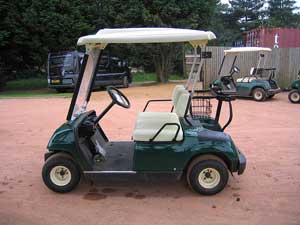Analyzing Argument Excerpts
Read the following excerpts from articles about whether a golfer who has a congenital leg disease and can’t walk should be allowed to use a golf cart in a PGA (Professional Golfers’ Association) tournament. Answer the questions that follow the second passage.

Source: 17th hole, Tournament Player’s Club at Sawgrass, St. Johns County Visitors & Conventions Bureau, Wikimedia Commons
Passage 1:
An excerpt from “Keep the PGA on Foot” by professional golfer Tom Kite
I have to work harder every year to stay competitive, but I would not think about asking for a cart. No one could have benefited more from using a cart than Ben Hogan, who won the United States Open in 1950 after recovering from injuries sustained in a car crash, even though every step he took was a painful ordeal. Hogan is considered perhaps the greatest shot maker the game has ever seen, but he knew that shot making is only part of the game.
The mental, physical, and emotional aspects of the sport are closely linked. Fatigue can cause loss of concentration, which can cause poor shot selection, which can cause poor shot making, which can cause stress, which can cause more loss of concentration. I have seen a lot of tournaments over the years that were won or lost on the last few holes, when you have to be sharp mentally, physically, and emotionally.
No matter how much some may be rooting for Casey Martin and how we sympathize with his disability, we cannot change an integral aspect of our sport for any one person.

Source: Golf buggy, Richard Stowey, Wikimedia
Passage 2:
An excerpt from “Sorry, Free Rides Not Right” by newspaper sports columnist Bob Ryan
I definitely believe golf should loosen up. It needs to set aside its patrician airs and become more like a real sport.
And yet . . . and yet there is no doubt in my mind that golf should dig in and fight on this Casey Martin business. If you can't walk the course, you can't play; it really is no more complicated than that.
I can admire Casey Martin. I can root for him to succeed in life. But that doesn't mean I think he should be riding a cart on a golf tour. If everyone else does, well, there’s nothing to talk about. Until then, I say no.
In the event you’ve just returned from a vacation in Antarctica, Casey Martin is the 25-year-old golfer—a onetime Stanford roommate of Tiger Woods, interestingly enough—who is affected with a congenital circulatory condition in his lower right leg known as Klippel-Trenaunay-Weber syndrome. Said condition makes it very painful for him to walk. He can hit the shots, but in order to be in a position to do so, he must get to the ball with the aid of a golf cart.
Type in your answer using your notes. When you are finished, check your understanding.
- What logical reasoning order does Kite use? How do you know?
- What logical reasoning order does Ryan use? How do you know?
- How does the order of each passage affect the tone? Describe the tone of each.
- What have you learned about each writer? Why is Kite's tone different from Ryan’s?
Sample Responses:
- Kite uses inductive reasoning. His claim is the last sentence. All the other sentences are reasons he has arrived at this conclusion.
- Ryan uses deductive reasoning. His main claim is his fourth sentence. The sentences that follow give all the reasons Casey Martin shouldn’t be allowed to use a golf cart.
- Kite’s tone is kinder, more conciliatory because his claim comes last. Ryan’s tone is blunter, harsher because he places his claim early in his argument.
- Tom Kite is a professional golfer. He must get along with his fellow golfers, including Casey Martin, and knows that he cannot be totally objective about the situation since he is directly affected by it. Therefore, he builds up to his conclusion, which he expresses in a caring manner. Bob Ryan is a sports columnist and has nothing to lose by stating flatly near the beginning of his argument exactly what he thinks about the situation.